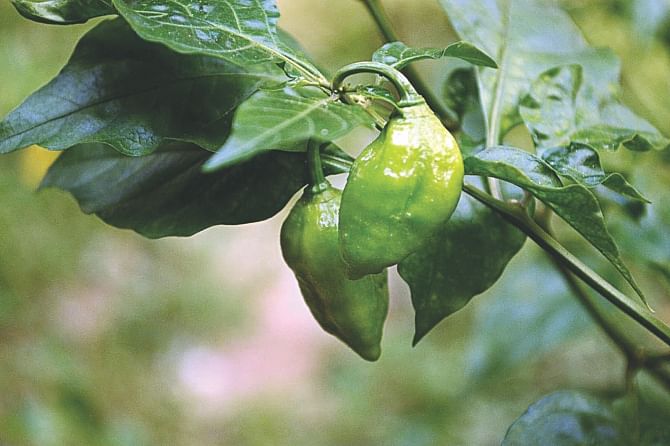Hot, Hotter, Hottest

In 2009, the environmental scientist Dr. Zakir Hussain was working in Bangkok as Director of the International Union for Conservation of Nature (IUCN). At a meal with Thai colleagues, he heard them boasting about how hot the Thai chili peppers were. At some point during the bragging, he could hold back no longer. “Thai chilis are nothing compared to Naga morich,” he informed his colleagues. Not taking him seriously was the first mistake the Thais made.
The next time Dr. Hussain went home to Bangladesh, he brought some fresh Naga morich for his Thai colleagues. He gave them the peppers as they were going to lunch one day, saying “Be careful, they are very hot.” The Thais then made their second mistake by paying no heed to his warning. Their third mistake followed soon: they casually started chewing the chilis with their lunch.
What followed was pandemonium as some started choking and others gasped in agony. Upon hearing the commotion, Dr. Hussain rushed downstairs to the lunchroom. “Why didn't you tell us it was THIS hot?” they complained to him.
Indeed, the Naga morich or bhut jolokia is the hottest naturally occurring chili pepper in the world. It is “endemic” to Bangladesh (specifically, Sylhet) and Assam. That is, it only grows in those areas. Its spiciness is confirmed by its rating of one million in the Scoville scale.
The Scoville scale measures the spiciness (jhal) of a chili pepper. Basically the idea is to extract – under precise laboratory conditions - a quantity of the hot substance (capsaicin) present in the pepper. This substance is then mixed into a solution of sugar water in increasing concentration. Several human testers taste this mix every time its concentration is increased until the instant they can taste the jhal. The chili pepper is assigned a Scoville heat unit based on the concentration at this point.
Some Scoville numbers are as follows: capsicum is zero and our normal kacha morich is around 100,000. Bird's eye chili pepper, the Thai favourite, ranges between 150,000 and 200,000. The Habanero pepper weighs in at 300,000. Beyond the Naga morich are the Trinidad Moruga Scorpion and the Carolina Reaper chili peppers, both produced by cross-breeding, scoring around a million and half.
The Naga morich, which is also 400 times hotter than Tabasco sauce, loses its extreme heat if grown outside its native home. It is easy to grow and bears fruit within a year. Its seeds are its hottest part but the flesh is nothing to scoff at.
My experience with Naga morich dates from childhood when a teasing cousin rubbed a slice of it on my nose which turned red and swelled up. Since then, I have maintained a safe distance from it.
But the aficionados swear by it. Dr. Manzurul Haque, a devoted Naga morich fanatic, collects Mr. Naga pickles and Naga shutki every time he visits London as one can only find them there. Besides achar and shutki, Naga morich is also eaten in curries. And of course raw, for the very brave.
Can the spiciness of Naga morich be used elsewhere? The Indians have reportedly experimented with a spray made from it. Apparently the plan is to use it against errant wild elephants. I am already feeling sorry for the said elephants.
www.facebook.com/tangents.ikabir

 For all latest news, follow The Daily Star's Google News channel.
For all latest news, follow The Daily Star's Google News channel. 



Comments